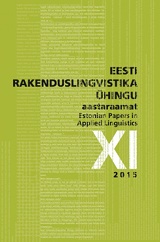Morfonotaktika leedu keele omandamisel esimese keelena:
Morphonotactics in L1 acquisition of Lithuanian:
td vs. sli
Author(s): Laura Kamandulytė-MerfeldienėSubject(s): Theoretical Linguistics, Phonetics / Phonology, Morphology
Published by: Eesti Rakenduslingvistika Ühing (ERÜ)
Keywords: morphonology; consonant cluster; phonotactics; morpheme; morpheme boundary; Lithuanian
Summary/Abstract: The aim of the present study is to test the Strong Morphonotactic Hypothesis (SMH), according to which speakers use morphonotactic consonant clusters as morphological boundary signals (Korecky-Kröll et al. 2014). It is hypothesized that morphonotactic clusters will be better retained during production than phonotactic clusters due to the function fulfilled by a morpheme. The study is based on experimental data collected from 60 Lithuanian TD children and 11 Lithuanian SLI children. This study explores the impact of morphology on the acquisition of phonotactics. The findings suggest that TD children process morphonotactic clusters more accurately than phonotactic clusters because morphonotactic clusters have the function of co-signalling the existence of a morphological rule. In contrast to TD children, for SLI children prototypical morphonotactic clusters are the most difficult as SLI children are not sensitive to morphological information which is carried by morphonotactic clusters.*
Journal: Eesti Rakenduslingvistika Ühingu aastaraamat
- Issue Year: 2015
- Issue No: 11
- Page Range: 95-109
- Page Count: 15
- Language: Estonian

